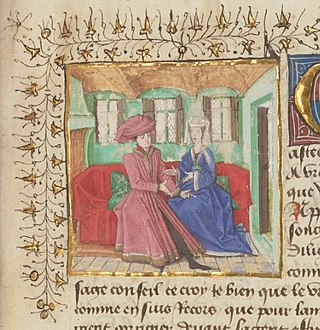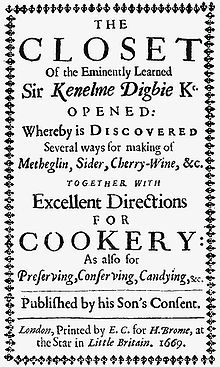
Mead, also called hydromel, is an alcoholic beverage made by fermenting honey mixed with water, and sometimes with added ingredients such as fruits, spices, grains, or hops. The alcoholic content ranges from about 3.5% ABV to more than 20%. The defining characteristic of mead is that the majority of the beverage's fermentable sugar is derived from honey. It may be still, carbonated, or naturally sparkling; dry, semi-sweet, or sweet.

English cuisine encompasses the cooking styles, traditions and recipes associated with England. It has distinctive attributes of its own, but is also very similar to wider British cuisine, partly historically and partly due to the import of ingredients and ideas from the Americas, China, and India during the time of the British Empire and as a result of post-war immigration.

A pasty is a British baked pastry, a traditional variety of which is particularly associated with Cornwall, South West England, but has spread all over the British Isles. It is made by placing an uncooked filling, typically meat and vegetables, in the middle of a flat shortcrust pastry circle, bringing the edges together in the middle, and crimping over the top to form a seal before baking.

Sir Kenelm Digby was an English courtier and diplomat. He was also a highly reputed natural philosopher, astrologer and known as a leading Roman Catholic intellectual and Blackloist. For his versatility, he is described in John Pointer's Oxoniensis Academia (1749) as the "Magazine of all Arts and Sciences, or the Ornament of this Nation".

Pirozhki are foremost, Russian baked or fried yeast-leavened boat-shaped buns with a variety of fillings. Pirozhki are a popular street food and comfort food in Eastern Europe.
Queen of Puddings is a traditional British dessert, consisting of a baked, breadcrumb-thickened egg mixture, spread with jam and topped with meringue. Similar recipes are called Monmouth Pudding and Manchester Pudding.

The Art of Cookery Made Plain and Easy is a cookbook by Hannah Glasse (1708–1770) first published in 1747. It was a bestseller for a century after its first publication, dominating the English-speaking market and making Glasse one of the most famous cookbook authors of her time. The book ran through at least 40 editions, many of which were copied without explicit author consent. It was published in Dublin from 1748, and in America from 1805.
Jane Barbara Stevenson is a British historian, literary scholar, and author.

Tatar cuisine is primarily the cuisine of the Volga Tatars, who live in Tatarstan, Russia, and surrounding areas.
Events from the year 1669 in England.

Le Ménagier de Paris is a French medieval guidebook from 1393 on a woman's proper behaviour in marriage and running a household. It includes sexual advice, recipes, and gardening tips. Written in the (fictional) voice of an elderly husband addressing his younger wife, the text offers a rare insight into late medieval ideas of gender, household, and marriage. Important for its language and for its combination of prose and poetry, the book's central theme is wifely obedience.
Cock ale, popular in 17th and 18th-century England, was an ale whose recipe consisted of normal ale, to which was later added a bag stuffed with a parboiled, skinned and gutted cock, and various fruits and spices.

Cornish cuisine encompasses the cooking styles, traditions and recipes associated with Cornwall and the Cornish people. It has been heavily influenced by the geography of the county as well as its social history.

Sponge cake is a light cake made with egg whites, flour and sugar, sometimes leavened with baking powder. Some sponge cakes do not contain egg yolks, like angel food cake, but most of them do. Sponge cakes, leavened with beaten eggs, originated during the Renaissance, possibly in Spain. The sponge cake is thought to be one of the first non-yeasted cakes, and the earliest attested sponge cake recipe in English is found in a book by the English poet Gervase Markham, The English Huswife, Containing the Inward and Outward Virtues Which Ought to Be in a Complete Woman (1615). Still, the cake was much more like a cracker: thin and crispy. Sponge cakes became the cake recognised today when bakers started using beaten eggs as a rising agent in the mid-18th century. The Victorian creation of baking powder by English food manufacturer Alfred Bird in 1843 allowed the addition of butter to the traditional sponge recipe, resulting in the creation of the Victoria sponge. Cakes are available in many flavours and have many recipes as well. Sponge cakes have become snack cakes via the Twinkie.

The Accomplisht Cook is an English cookery book published by the professional cook Robert May in 1660, and the first to group recipes logically into 24 sections. It was much the largest cookery book in England up to that time, providing numerous recipes for boiling, roasting, and frying meat, and others for salads, puddings, sauces, and baking. Eight of the sections are devoted to fish, with separate sections for carp, pike, salmon, sturgeon, and shellfish. Another section covers only eggs; and the next only artichokes.

Modern Cookery for Private Families is an English cookery book by Eliza Acton. It was first published by Longmans in 1845, and was a best-seller, running through 13 editions by 1853, though its sales were later overtaken by Mrs Beeton. On the strength of the book, Delia Smith called Acton "the best writer of recipes in the English language", while Elizabeth David wondered why "this peerless writer" had been eclipsed by such inferior and inexperienced imitators.
Battalia pie is an English large game pie, or occasionally a fish pie, filled with many small "blessed" pieces, beatilles, of offal, in a gravy made from meat stock flavoured with spices and lemon. The dish was described in cookery books of the 17th and 18th centuries.

The Cooks and Confectioners Dictionary: or, the Accomplish'd Housewives Companion was a cookery book written by John Nott and first published in London in 1723.

The Good Huswifes Jewell is an English cookery book by the cookery and housekeeping writer Thomas Dawson, first published in 1585. It includes recipes for medicines as well as food. To the spices found in Medieval English cooking, the book adds herbs, especially parsley and thyme. Sugar is used in many of the dishes, along with ingredients that are uncommon in modern cooking like violets and rosewater.

The Queen-like Closet, Or, Rich Cabinet was a cookery book published in 1670 by the English writer on household management, Hannah Woolley. It ran through five English editions by 1684. At least two German editions were also printed.















